#gluhschwanz
Explore tagged Tumblr posts
Text
i dont think any dragon concpt beats the gluhschwanz (glowtail) from german mythology, peak critter imo. chills on rooftops, climbs down chimneys of employers that treat their workers poorly to leave a dump on their carpet. they fly as fast as a comet, and catch on fire while doing so. measures 5 meters from head to tail, most of it being the tail. being treated more as a cryptid than a mythological beast
18 notes
·
View notes
Text


two mythological & folklore creature illustrations from last month!
a gentle & peaceful qilin, that is said to be able to walk on grass without distrubing it as well as a gluhschwanz, who's a cheeky pal that might drop some gold down your chimney if you're cool.
#aceo#qilin#kirin#dragon#gluhschwanz#gluten free gluhschwanz yes that is exactly what I wanted to tag this as
70 notes
·
View notes
Photo
Still confused why Drachen in general are on here while there are also a lot of specific dragons.
@a-book-of-creatures

From what I found out since our last talk about the topic, there are a bunch of cat-headed dragons in Scheuchzers writings, but not a single one of them is called a Tatzelwurm by Scheuchzer or any of his German language sources. Pretty sure the association comes from this, though.
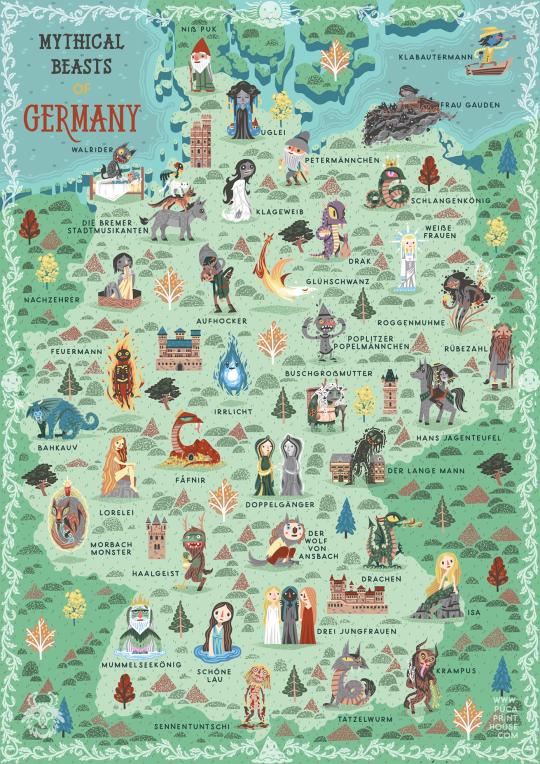
Mythical Beasts of Germany
by u/NeilParkinsonMakes
7K notes
·
View notes
Photo




Okay its name I could never say but at least I can write it, this dragon is based on the German mythological creature Gluhschwanz combined with the idea of a fire vortex
#digital#digital art#digital drawing#digitalart#digitalartwork#Fakemon#pokemon#creature#fantasy creature#creature design#fire#dragon#fire type#dragon type#gluhschwanz
30 notes
·
View notes
Photo

the gluhschwanz (can translate into embertail or glowtail) is a dragon from german folklore that resembles a shooting star.
129 notes
·
View notes
Text
What's also interesting is that there is indeed some overlap between kobolds and dragons in German folklore, but from what I could find, this had no influence on D&D and all the newer examples you mentioned whatsoever.
This is a question that’s been bothering me, and after looking into it I think I get it
So kobolds first appear in Germanic folklore as domestic spirits. Kobolds are also considered mine spirits, causing cave-ins and tapping on things in the dark to scare miners
Think the elves from The Elves and the Shoemaker, but bastards
This association with mines and caves and bastardy gets them into the world of tabletop RPGs when Gary Gygax adds them to his fantasy supplement of Chainmail. Kobolds are later added to Dungeons & Dragons as a subterranean race of monsters
Here’s the important thing: due to a throwaway line in the rulebooks about the kobolds having doglike voices, the first artist to depict a D&D kobold gave it a dog nose

This is the beginning point in the divergent evolution
Kobolds in western TTRPG will notoriously become more and more reptilian with each generation, leaning on the interpretation of “chihuahua dragons,” but it’s at this time, heavily inspired by Dungeons & Dragons, that the video game series Wizardry begins
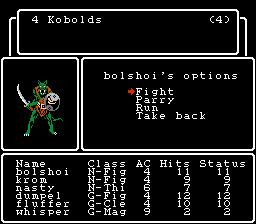
They brought the dog kobolds with them
Wizardry becomes extremely popular in Japan, inspiring JRPG series like Dragon Quest and Final Fantasy as well as manga series like Dungeon Meshi. And while in the west the kobold has become increasingly reptilian with each edition, the Japanese kobold has become increasingly canine
And this is why in the greater fantasy genre, kobolds represent everything from

To
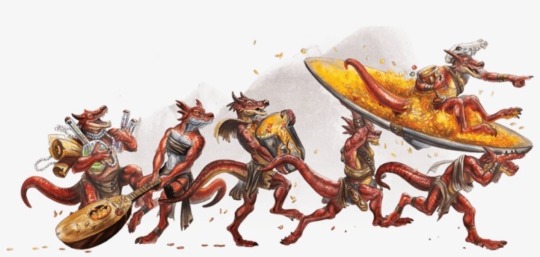
To

And

9K notes
·
View notes
Note
Hey Robin! It's for Ask the Blogger. Do you have a favourite trope? What kind of folklore/mythical creature would you like to become (if any at all) and why?
I’m not sure I have A Favourite. But I do tend to gravitate towards all kinds of found family dynamics and hurt/comfort!
Number one on my list of creatures to become is a vampire and for obvious reasons (I know, very cliché lol),
but I just read up on mythical creatures in my area and I’ve already developed a soft spot for the Gluhschwanz (”glow tail”; a type of glowing dragon most likely based on shooting stars) They’re said to give witches grain or money in exchange for sweet milk and enter their homes through the chimney. No milk means setting the witches’ chimneys on fire tho
Another Gluhschwanz story tells of them flying over the houses of people who have done wrong, illuminating the home and pointing them out for all to see.
Sometimes these dragons would also drop something down the chimneys of dishonest people, spoiling the curing meat and causing an awful smell to stick around the house for weeks!
Honest people would be gifted Taler (old German coins) by these creatures, once again delivered via chimney.
So, kind of a Northern German Robin Hood/Santa in glowing dragon form who is cool with witches most of the time! :3
Turning into that kind of creature would be pretty cool! 😍
#...now i actually want to read more about the local traditions and folklore in my area#i don't know any of it. i just live here orz#so thank you so much for the ask and making me discover new things that way! ♥#ask robin#castirondoll
3 notes
·
View notes
Text
In German Folklore there is a friendly little dragon creature called Gluhschwanz (Literally: "Glowing Tail") who would fly about the night sky with their tail appearing like a Comet as they fly about at night. If you feed the Gluhschwanz cheese then it will serve you, pulling a reverse Santa: Diving down people's chimney and stealing shiny trinkets to bring back to their master, however they also have a weird sense of justice. Basically it's ok when THEY steal things from people's homes, but if they see anybody else breaking into homes and stealing thing then they will expose their actions by using their glowing tail like spotlight. Then if for whatever reason the burglars escape the Gluhschwanz, then it will find out where they live and take a shit in their chimney.

glowy tail nightwing oh yeah
#wof#dragon#wof nightwing#nightwing#German#german folklore#Gluhschwanz#Glowing Tail#Reverse Santa#Also known as pulling a Grinch#Because you paid it in cheese#Comet#This is also possibly the origin of Charizard#Chimney
929 notes
·
View notes
Text
Aitvaras

Rough doodle of the aitvaras from Dracones Mundi - based on Finnish, Estonian, Latvian and Lithuanian folklore of small house demons which were sometimes chickens, sometimes cats, sometimes goblins and sometimes demons with flaming tails, I have interpreted this animal as a relative of the cockatrice. Their native range is in fact in South East Asia where they are known as Bajunga, a glowing tailed protector of the forest. In Europe they are known as kaukas, aitvaras and gluhschwanz.
This is an unfinished design as my cockatrices have feet that change in every drawing, sliding up and down between long toes for perching (seen above) and chubby alligator paws (how I tend to draw most Dracones Mundi dragon feet, because these dragons are related to crocodiles). This animal has a covering of scales, and the long rough looking scales around the forequarters may look like feathers from a distance but are in fact psuedopennae. The wings are not like bat wings but more like fish fins - membranes spread between ossified rods. It’s basically a small fat crocodile pretending to be a chicken and it’s cute.
I’ve not decided much on glowing tail appearance aside from ‘mmmm orange glow’, so if you see funky patterns or shapes in my next aitvaras image than I’ve finally decided something XD
17 notes
·
View notes
Text
According to folklore, they should at least bring you milk, grain and money. But be aware that it might be stolen from your neighbours.


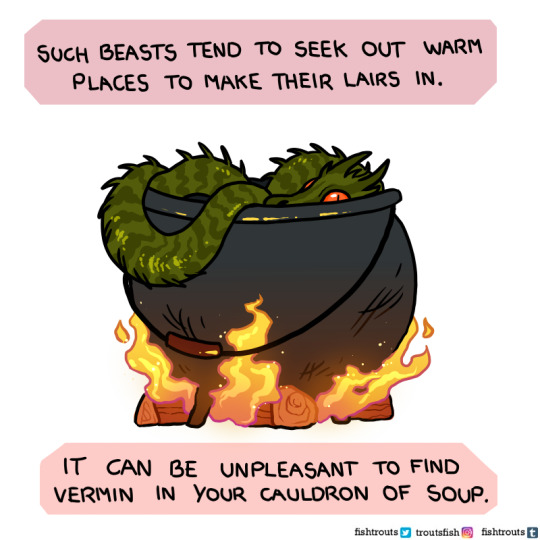

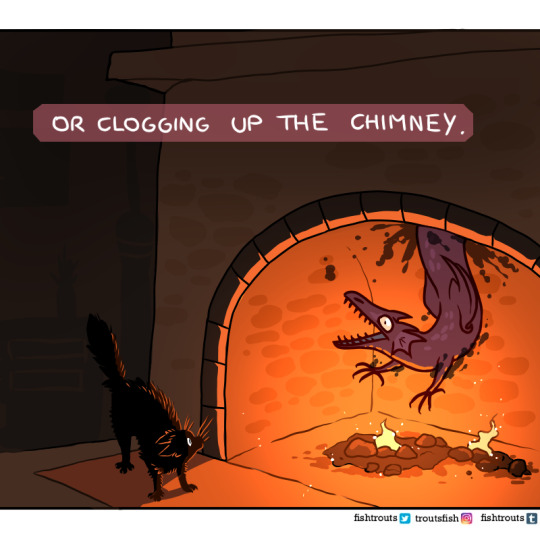
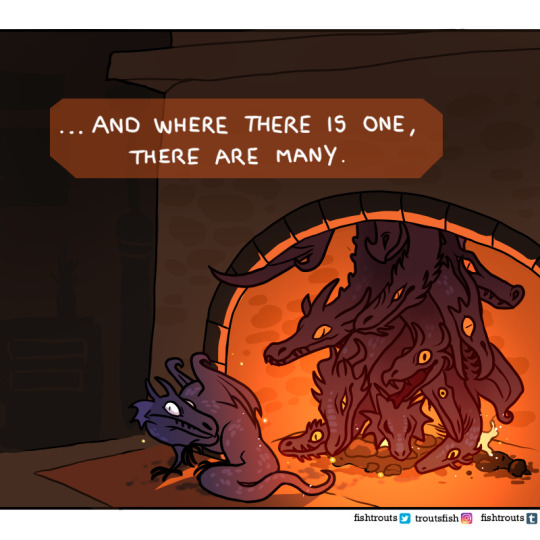

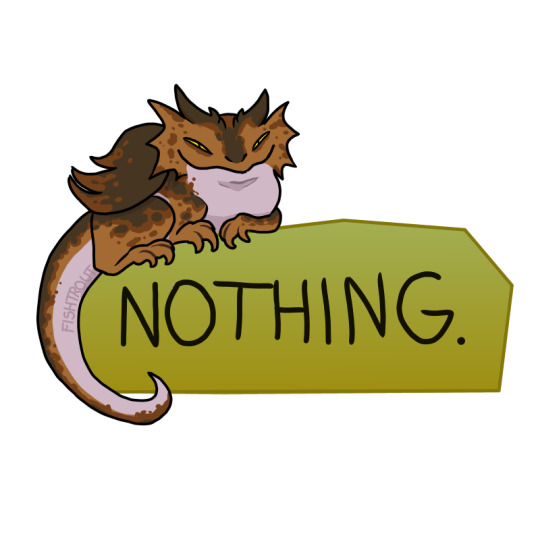


Happy Halloween to all the little wyrmlings!! I’m in university now so there’s been a loooong wait for the next comic, but here it is!
Patreon | Redbubble | Webtoon
37K notes
·
View notes
Text
@bogleech while the Tilberi is specifically an Icelandic thing, witches stealing butter and using their familiars for this purpose was a pretty widespread belief in Europe. The Swedish counterpart is the bjära (also known as trollhare or trollkatten), which, as the name implies, is thought to look like a hare or cat. The Finnish para appears as snake, dog or rabbit, the Baltic puk as snake or cat and the Sorbian plón or zmij as snake, calf, chicken or piglet.
In German speaking countries, there's the Gluhschwanz or Drak, which is sometimes also called Kobold and is most often described as a fireball in the sky, but very often compared to a "Wiesbaum", which is the pole you put on top of a haywagon so the hay doesn't fall off. And by compared I mean anything from simply being the same size to actually looking like a flying, burning pole, sometimes with the addition of several animal parts. But I've also heard descriptions as snakes, cats, magpies, hares, dogs, werewolves or even haystacks. So yeah, this kind of witch or witch's familiar stealing milk or butter, and also corn and money, is pretty widespread.
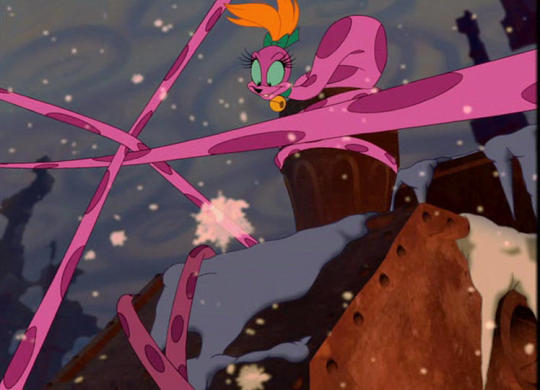
I never saw Don Bluth's Bartok the Magnificent (the only video sequel to any of his movies that he actually worked on) until days ago and all my life I thought this thing on the video cover was just the worst design I'd ever seen for a snake. I had no idea "Piloff" was actually a weird unnatural thingamajig made by Baba Yaga as a familiar, and maybe she's just one of Don Bluth's many bewildering (affectionate) original ideas, but there is a precedent in Icelandic folklore for a stretchy wormlike thing created by witches.
As an aside this movie came out when I was just discovering the internet animation fandom and I kept running into people who had a raging fetish for this character. Well I hope 23 years later they can accept their wife for what I'm now adamant she actually is, a Tilberi:
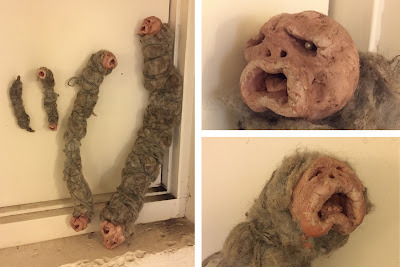
Possibility it's more than coincidence: a Tilberi is created by a witch to be sent out into the countryside and steal milk from farms, used by the witch in various spells or just to make evil butter (not a joke but the single most commonly cited purpose. The butter is harmless but you can draw a sign on it that will reveal its wicked origin) so in this movie Bartok has to go fetch Piloff because she got lost and as soon as she comes home Baba Yaga wrings her out to get some kind of fluid for her potion. Tilberi are Icelandic and Baba Yaga is Slavic but Poles are the largest ethnic minority in Iceland so Baba Yaga was pretty well known there even before she really took off as a globally famous concept and so it's a given anyone in Iceland who knew about Tilberi (and they aren't terribly obscure; these photos are from the Icelandic Museum of Witchcraft!) would have assumed Baba Yaga has at least one.
830 notes
·
View notes
Text
I found a page that mentions domestic dragons of Heidelberg: http://bestiarium.net/heidel.html
Unfortunately I have no idea what's their source. But in my experiemce, I always eventually stumbled upon the original sources of what I've read at bestiarum.net earlier.
I also don't know many wyverns in Germany. The legends I know often don't describe the dragon very closely, but with the Coat of Arms of Klagenfurt in Austria I know at least one wyvern in German-language heraldry.
Here be Dragons!
Tell me where you are in the world (country, or province of a large country) and I will tell you which dragons are local there according to Dracones Mundi!
#wyvern#western dragon#dracones mundi#lindworm#lindwurm#aitvaras#cockatrice#gluhschwanz#fafnir#tatzelwurm
155 notes
·
View notes